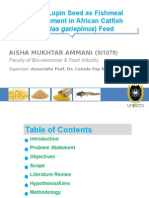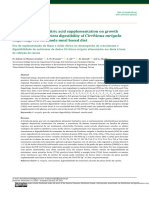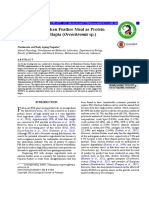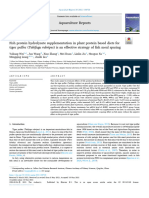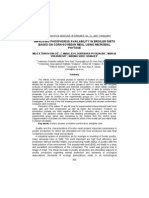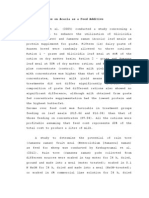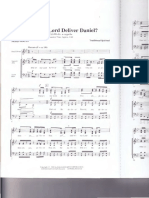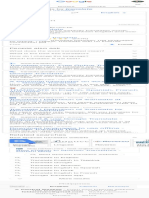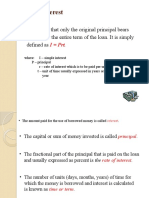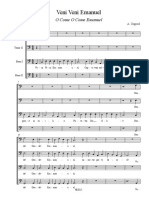Crude Protein: Table 4
Crude Protein: Table 4
Uploaded by
Prince Marc Cabelleza DanielCopyright:
Available Formats
Crude Protein: Table 4
Crude Protein: Table 4
Uploaded by
Prince Marc Cabelleza DanielOriginal Description:
Original Title
Copyright
Available Formats
Share this document
Did you find this document useful?
Is this content inappropriate?
Copyright:
Available Formats
Crude Protein: Table 4
Crude Protein: Table 4
Uploaded by
Prince Marc Cabelleza DanielCopyright:
Available Formats
Similarly, Samocha et al.
(2004) stated that the survival, final weight and Feed
Efficiency (FE) were not significantly different when co-extruded soybean poultry
by-product with egg supplement was substituted for fish feed meal in a practical
diet formulated to contain 32% crude protein and 8% lipid.
Feed Conversion Ratio (FCR): The FCR by the fish ranged from 168-2.09 fed on
different diets (Table 4). There was a significant difference in FCR between the
control (ARASCO feed) and the extruded feed treatments (LSD0.05 = 0.827).
Highest FCR was obtained with extruded feed without premix as compared to
the extruded feed with premix and the commercial feed (ARASCO). This showed
that extruded feed can successfully be used in aquaculture as an alternate
source of protein in fish diet. It will further minimize the commercial feed import
issue for the fish growers.
Specific Growth Rate (SGR): The SGR of Nile tilapia ranged from 0.91-1.10 fed on
different diets (Table 4). There was no significant difference in SGR of Nile tilapia
among various feeds (LSD0.05 = 0.365). But there was a decreasing trend in SGR
with extruded feed with and without premix than the commercial feed (ARASCO).
This suggests that fish can easily be reared on extruded feed for optimal
production. The results agree with those of Rodriguez et al. (1996) who
concluded that animal by-product meal can be used as a sole protein source in
commercial feed for Nile tilapia fry without affecting growth and food utilization.
Protein Efficiency Ratio (PER): The PER of Nile tilapia ranged from 1.47-1.75 fed
on different feeds (Table 4). There was a significant difference in FER among
different fish diets (LSD0.05 = 0.124). The PER decreased significantly with
extruded feed without premix as compared to the control treatment (ARASCO
Feed) and the extruded feed with premix. This could be due to more
consumption of ARASCO feed by fish than the extruded feed for higher PER.
Similarly, Samocha et al. (2004) stated that the survival, final weight and FE were
not significantly different when co-extruded soybean poultry by-product with
egg supplement was substituted for fish feed meal in a practical diet formulated
to contain 32% crude protein and 8% lipid.
You might also like
- The Prince of Egypt - When You-BelieveDocument10 pagesThe Prince of Egypt - When You-BelievePrince Marc Cabelleza Daniel50% (2)
- The Impact of Dietary Black Soldier Fly Larvae Oil and Meal On Laying Hen Performance 2021Document26 pagesThe Impact of Dietary Black Soldier Fly Larvae Oil and Meal On Laying Hen Performance 2021Bolivar Gonçalves HencesNo ratings yet
- Effects of Mixed Feeding Schedules On Growth Performance, Body Composition, and Nitrogen-And Phosphorus Balance in Rainbow Trout, Oncorhynchus MykissDocument7 pagesEffects of Mixed Feeding Schedules On Growth Performance, Body Composition, and Nitrogen-And Phosphorus Balance in Rainbow Trout, Oncorhynchus MykissKadekLilaAntaraNo ratings yet
- Articulo de Camarón-KernelDocument8 pagesArticulo de Camarón-Kerneleulalio.arambulNo ratings yet
- Performance of Broiler Chickens Fed Diets Containing Cassava Leaf: Blood Meal Mix As Replacement For Soybean MealDocument9 pagesPerformance of Broiler Chickens Fed Diets Containing Cassava Leaf: Blood Meal Mix As Replacement For Soybean MealRowel ManicapNo ratings yet
- Goldfish (IAAS Journal)Document8 pagesGoldfish (IAAS Journal)Shailesh GurungNo ratings yet
- Comparative Effects of Fertilization and Supplementary Feed On Growth Performance of Three Fish SpeciesDocument5 pagesComparative Effects of Fertilization and Supplementary Feed On Growth Performance of Three Fish SpeciesAhmed RashidNo ratings yet
- Lupin Seed As Replacement For Fishmeal in African Catfish (Clarias Gariepienus) FeedDocument26 pagesLupin Seed As Replacement For Fishmeal in African Catfish (Clarias Gariepienus) FeedBashir Muzakkar100% (1)
- Article RSM & FRSMDocument14 pagesArticle RSM & FRSMJaved ShaikhNo ratings yet
- Use of Phytase and Citric Acid Supplementation On Growth Performance and Nutrient Digestibility of Cirrhinus Mrigala Fingerlings Fed On Canola Meal Based DietDocument12 pagesUse of Phytase and Citric Acid Supplementation On Growth Performance and Nutrient Digestibility of Cirrhinus Mrigala Fingerlings Fed On Canola Meal Based Dietmana khantNo ratings yet
- Nursinatrya RudyDocument8 pagesNursinatrya RudyMazz RudyNo ratings yet
- Partial or Total Replacement of Dietary Fish Oil With Alternative Lipid Sources in Silvery-Black Porgy (Sparidentex Hasta)Document9 pagesPartial or Total Replacement of Dietary Fish Oil With Alternative Lipid Sources in Silvery-Black Porgy (Sparidentex Hasta)Fahad Al AjmiNo ratings yet
- Meshram 2018Document10 pagesMeshram 2018lethienvi1102No ratings yet
- The Effects of Dietary Bee Pollen On Lipid Peroxidation and Fatty Acids Composition of Japanese Quails (Coturnix Coturnix Japonica) Meat Under Different Stocking DensitiesDocument6 pagesThe Effects of Dietary Bee Pollen On Lipid Peroxidation and Fatty Acids Composition of Japanese Quails (Coturnix Coturnix Japonica) Meat Under Different Stocking DensitiesJhon Jairo UmañaNo ratings yet
- Review of Related Literature and StudiesDocument3 pagesReview of Related Literature and Studiesjek vinNo ratings yet
- 1 s2.0 S0044848620324583 MainDocument12 pages1 s2.0 S0044848620324583 Maintrisha.bau3No ratings yet
- Protein Sparing in Tilapia Through Supplementation of A Digestive - Metabolic Enhancer - The Fish SiteDocument8 pagesProtein Sparing in Tilapia Through Supplementation of A Digestive - Metabolic Enhancer - The Fish SiteRui GonçalvesNo ratings yet
- References: ConclusionsDocument1 pageReferences: ConclusionsFeldan Marc DanielNo ratings yet
- 1 s2.0 S105661711930340X MainDocument14 pages1 s2.0 S105661711930340X MainsanielNo ratings yet
- EFFECT OF DIETARY FISH MEAL REPLACEMENT BY POULTRY BY-PRODUCT MEAL ON MUSCLE FATTY Acid COMPOS-T-ON AND Liver Histology PDFDocument10 pagesEFFECT OF DIETARY FISH MEAL REPLACEMENT BY POULTRY BY-PRODUCT MEAL ON MUSCLE FATTY Acid COMPOS-T-ON AND Liver Histology PDFRaluca GuriencuNo ratings yet
- Remplaso de Aceite de Pescado Por Aceite de Palma y La Acumulacion de Tocoferoles en Musculo de Pez GatoDocument15 pagesRemplaso de Aceite de Pescado Por Aceite de Palma y La Acumulacion de Tocoferoles en Musculo de Pez GatoOscar Fregoso AguirreNo ratings yet
- 1 s2.0 S2352513421001368 MainDocument8 pages1 s2.0 S2352513421001368 MainWahyu PamungkasNo ratings yet
- A Nutritional Evaluation of Insect Meal As A Sustainable Protein Source For Jumbo Quails: Physiological and Meat Quality ResponsesDocument4 pagesA Nutritional Evaluation of Insect Meal As A Sustainable Protein Source For Jumbo Quails: Physiological and Meat Quality Responsesmelanie llagasNo ratings yet
- 1 s2.0 S2352513423003812 MainDocument9 pages1 s2.0 S2352513423003812 Maineng.cherllekallyNo ratings yet
- Use of Azolla Pinnata (RRL)Document9 pagesUse of Azolla Pinnata (RRL)Jennie Marlow AddisonNo ratings yet
- Cristalyn Powerpoint OutlineDocument28 pagesCristalyn Powerpoint OutlinePrincess Piamae EdoriaNo ratings yet
- Response of Fermented Cladophora Containing Diet On Growth Performances and Feed Efficiency of Tilapia (Oreochromis SP.)Document8 pagesResponse of Fermented Cladophora Containing Diet On Growth Performances and Feed Efficiency of Tilapia (Oreochromis SP.)International Network For Natural SciencesNo ratings yet
- Improving Phosphorus Availability in Broiler Diets Based On Corn-Soybean Meal Using Microbial PhytaseDocument7 pagesImproving Phosphorus Availability in Broiler Diets Based On Corn-Soybean Meal Using Microbial PhytaseSarah Tarala MoscosaNo ratings yet
- outlineDocument18 pagesoutlineAhmed AbdulrahmanNo ratings yet
- Azolla FoundationLivestock FeedDocument6 pagesAzolla FoundationLivestock FeedThamil ArasanNo ratings yet
- Feed FormulationDocument42 pagesFeed Formulationalam zanNo ratings yet
- As FeedDocument14 pagesAs FeedPawankumar TiwariNo ratings yet
- 1 s2.0 S0044848622007347 MainDocument11 pages1 s2.0 S0044848622007347 MainGelene Roda AlvarezNo ratings yet
- Growth Performance of Mirror Carp (Cyprinus Carpio Var. Specularis, Lacepède, 1803) Fry Fed With Varying Protein Content FeedsDocument7 pagesGrowth Performance of Mirror Carp (Cyprinus Carpio Var. Specularis, Lacepède, 1803) Fry Fed With Varying Protein Content FeedsdennysNo ratings yet
- Laying Performance of Japanese Seattle Quail Supplemented With Different Levels of Azolla MealDocument3 pagesLaying Performance of Japanese Seattle Quail Supplemented With Different Levels of Azolla Mealwynferd ssNo ratings yet
- Effect of Feeding AzollaDocument5 pagesEffect of Feeding AzollaTarigNo ratings yet
- JAHP MH20151125151102 NasrawiDocument7 pagesJAHP MH20151125151102 Nasrawiaisheykapattersonsba24No ratings yet
- Related Studies On Acacia As A Feed AdditiveDocument5 pagesRelated Studies On Acacia As A Feed AdditivePamela Anne CanlasNo ratings yet
- A Review On Replacing Fish Meal in Aqua Feeds Using Plant Protein SourcesDocument17 pagesA Review On Replacing Fish Meal in Aqua Feeds Using Plant Protein SourcesroraysideblancoNo ratings yet
- Abdulhalim 2014Document10 pagesAbdulhalim 2014Nguyen Minh TrongNo ratings yet
- Effect of Cassia Tora Leaves On Growth Performance of Labeo RohitaDocument3 pagesEffect of Cassia Tora Leaves On Growth Performance of Labeo RohitaInternational Journal of Innovative Science and Research TechnologyNo ratings yet
- Hassan 2021Document22 pagesHassan 2021Maykelly da Silva GomesNo ratings yet
- Hatlen 2012Document12 pagesHatlen 2012Juan José Aparicio PorresNo ratings yet
- The Influence of Addition Fat On Poultry Performance and Carcass Lipids Profile. A ReviewDocument6 pagesThe Influence of Addition Fat On Poultry Performance and Carcass Lipids Profile. A ReviewInternational Journal of Innovative Science and Research TechnologyNo ratings yet
- Effects of Dietary Hydroxyproline on Growth Performance, Body Composition, Hydroxyproline and Collagen Concentrations in Tissues in Relation to Prolyl 4-Hydroxylase α(I) Gene Expression of Juvenile Turbot, Scophthalmus Maximus L.Document8 pagesEffects of Dietary Hydroxyproline on Growth Performance, Body Composition, Hydroxyproline and Collagen Concentrations in Tissues in Relation to Prolyl 4-Hydroxylase α(I) Gene Expression of Juvenile Turbot, Scophthalmus Maximus L.陈浩No ratings yet
- Effects of A Combination of Xylanase Amylase and Protease and PR - 2019 - PoulDocument11 pagesEffects of A Combination of Xylanase Amylase and Protease and PR - 2019 - PoulAleneNo ratings yet
- Pakistan Veterinary Journal: Chemical Composition and Nutrient Digestibility of Super Worm Meal in Red Tilapia JuvenileDocument5 pagesPakistan Veterinary Journal: Chemical Composition and Nutrient Digestibility of Super Worm Meal in Red Tilapia JuvenilerajrudrapaaNo ratings yet
- AcuicuturaDocument9 pagesAcuicuturagengiNo ratings yet
- Different Responses of Grass Carp Ctenopharyngodon Idellus A - 2023 - AquacultDocument8 pagesDifferent Responses of Grass Carp Ctenopharyngodon Idellus A - 2023 - AquacultHafez A MabroukNo ratings yet
- 018 28646am110615 153 164Document12 pages018 28646am110615 153 164encikanshari17No ratings yet
- Black Soldier Fly (Hermetia Illucens) Larvae-Meal As An Example For A New Feed Ingredients' Class in Aquaculture DietsDocument4 pagesBlack Soldier Fly (Hermetia Illucens) Larvae-Meal As An Example For A New Feed Ingredients' Class in Aquaculture DietsOscar VicenteNo ratings yet
- 1 s2.0 S0377840117316176 MainDocument12 pages1 s2.0 S0377840117316176 MainlucianamartinezluqueNo ratings yet
- ResearchhhDocument4 pagesResearchhhTAAYNo ratings yet
- Influence of Branched Chain Amino Acid Inclusion in Diets V - 2020 - Journal ofDocument18 pagesInfluence of Branched Chain Amino Acid Inclusion in Diets V - 2020 - Journal ofmohamed nageebNo ratings yet
- 05 Asratetal2009 SINETDocument7 pages05 Asratetal2009 SINETmichelle jumao-asNo ratings yet
- Pla RabbitDocument12 pagesPla Rabbitivana.vrdoljak.osNo ratings yet
- Angga Pratama Haloho - 2003511035 - Abstract Assigment - Class ADocument3 pagesAngga Pratama Haloho - 2003511035 - Abstract Assigment - Class AChristmas14 ManjorangFMIPANo ratings yet
- The Effects of Dietary Turnip (Brassica Rapa) and Biofuel Algae On Growth and Chemical Composition in Rainbow Trout (Oncorhynchus Mykiss) JuvenilesDocument7 pagesThe Effects of Dietary Turnip (Brassica Rapa) and Biofuel Algae On Growth and Chemical Composition in Rainbow Trout (Oncorhynchus Mykiss) JuvenilesKatarzinaNo ratings yet
- AnimalsDocument10 pagesAnimalsGabriela LusiNo ratings yet
- AQUACULTUREDocument13 pagesAQUACULTUREsoroNo ratings yet
- Nutritional Management of Equine Diseases and Special CasesFrom EverandNutritional Management of Equine Diseases and Special CasesBryan M. WaldridgeNo ratings yet
- UTILITIESDocument36 pagesUTILITIESPrince Marc Cabelleza DanielNo ratings yet
- School Class Shifting ScheduleDocument1 pageSchool Class Shifting SchedulePrince Marc Cabelleza DanielNo ratings yet
- Ride On King Jesus HoganDocument11 pagesRide On King Jesus HoganPrince Marc Cabelleza DanielNo ratings yet
- Didnt My Lord Deliver DanielDocument6 pagesDidnt My Lord Deliver DanielPrince Marc Cabelleza DanielNo ratings yet
- Redeemer of The Rain LyricsDocument1 pageRedeemer of The Rain LyricsPrince Marc Cabelleza DanielNo ratings yet
- Safari - Oct 1, 2020 at 4:56 AM 3Document1 pageSafari - Oct 1, 2020 at 4:56 AM 3Prince Marc Cabelleza DanielNo ratings yet
- The Ultimate List of Graphic Organizers For Teachers and StudentsDocument1 pageThe Ultimate List of Graphic Organizers For Teachers and StudentsPrince Marc Cabelleza DanielNo ratings yet
- Safari - Oct 1, 2020 at 4:57 AMDocument1 pageSafari - Oct 1, 2020 at 4:57 AMPrince Marc Cabelleza DanielNo ratings yet
- Safari - Oct 1, 2020 at 2:08 AM 2Document1 pageSafari - Oct 1, 2020 at 2:08 AM 2Prince Marc Cabelleza DanielNo ratings yet
- Simple Interest and Simple Discount-1Document16 pagesSimple Interest and Simple Discount-1Prince Marc Cabelleza DanielNo ratings yet
- Safari - Oct 1, 2020 at 2:08 AMDocument1 pageSafari - Oct 1, 2020 at 2:08 AMPrince Marc Cabelleza DanielNo ratings yet
- Safari - Sep 2, 2019 at 10:09 PMDocument1 pageSafari - Sep 2, 2019 at 10:09 PMPrince Marc Cabelleza DanielNo ratings yet
- He Touched Me LyricsDocument1 pageHe Touched Me LyricsPrince Marc Cabelleza DanielNo ratings yet
- People Also Ask: Promotional Talk About ThanksgivingDocument1 pagePeople Also Ask: Promotional Talk About ThanksgivingPrince Marc Cabelleza DanielNo ratings yet
- The Impact of Technology On Today S Learning EnvironmentDocument1 pageThe Impact of Technology On Today S Learning EnvironmentPrince Marc Cabelleza DanielNo ratings yet
- Safari - Sep 2, 2019 at 10:18 PM 3Document1 pageSafari - Sep 2, 2019 at 10:18 PM 3Prince Marc Cabelleza DanielNo ratings yet
- Safari - Sep 2, 2019 at 9:37 PMDocument1 pageSafari - Sep 2, 2019 at 9:37 PMPrince Marc Cabelleza DanielNo ratings yet
- Safari - Aug 23, 2019 at 6:21 AM PDFDocument1 pageSafari - Aug 23, 2019 at 6:21 AM PDFPrince Marc Cabelleza DanielNo ratings yet
- Veni Veni EmmanuelDocument3 pagesVeni Veni EmmanuelPrince Marc Cabelleza DanielNo ratings yet







